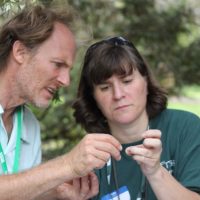Salal, a summer beauty
In the midst of our dry NW summer, while many plants look worse for wear, our native evergreen Salal shrubs, Gaultheria shallon, are shiny and healthy. Salal flowers in the spring with pinkish-white bell-shaped flowers in groups of 5-15 on racemes; very similar to the Pieris japonica flower. Both plants are in the Ericacea family. The Salal shrub can grown to 16′ tall and forms a dense mass that creates habitat and food for local birds and animals.
Read moreJuly Color Appears at the Washington Park Arboretum (Part II)
“Quirky Oaks”
1) Quercus x bushii ‘Seattle Trident’
(Seattle Trident Hybrid Red Oak)
Cultivar of a Black Oak and Blackjack Oak hybrid.
Developed in Sir Hillier Gardens and Arboretum in England from scion wood collected at Washington Park Arboretum.
Located in the Oak Collection, northwest of Azalea Way service road intersection.
2) Quercus dentata (Daimyo Oak)
Asian native (China, Korea, Japan, Mongolia)
Develops an unusually large leaf; occasionally used as a vegetable in native range.
Planting Party in the New Zealand Garden
Pacific Connections Garden Stewards made history on June 20th when they planted the New Zealand High Country plants into the new Bollard Garden in the new forest. They planted several species well over 20 years old. These include Nothofagus solanderi, Griselinia littoralis, Phyllocladus alpinus, Phormium colensoi, and Dodonaea viscosa. In addition to the Bollard Garden (aka The New Zealand High Country Display), the garden will include the Hebe Meadow, the Griselinia Bush, the Mountain Tussock, Snow Tussock, the Silver Beech Forest, the Phormium Fen and the Mountain Beech Zone.
Read moreJuly Color Appears at the Washington Park Arboretum
Chile in Seattle
1) Alstroemeria sp.
Commonly called Peruvian Lily or Lily of the Incas.
The genus was named after Swedish baron, Claus von Alstroemer (1736-1794) by his close friend, Carolus Linnaeus.
Beautiful drifts grace the Chilean Gateway.
2) Gunnera tinctoria
Sometimes referred to as Chilean rhubarb or dinosaur food.
The leaves can grow up to 2.5 meters across.
Several large clumps dot the Chilean Gateway hillside.
June Color Appears at the Washington Park Arboretum (Part II)
1) Callistemon sieberi (Alpine Bottlebrush)
This small, spreading shrub is currently showing off its creamy-yellow flowers in bottlebrush-like spikes.
Native to Australia, C. sieberi can be found along the footpath of the Australian Entry Garden within the Pacific Connections Garden.
2) Cytisus battandieri (Pineapple Broom)
Sometimes referred to as Argyrocytisus, this genus of Brooms fall within the family, Fabaceae.
Native to Morocco, C.
June Color Appears at the Washington Park Arboretum
1) Illicium henryi (Henry’s Star Anise)
This Chinese Illicium is a standout of the genus, as most anise have white or cream-colored flowers.
I. henryi can be found along the foot path of the Sino-Himalayan Hillside as well as along the Ridgetop Trail, just west of the Magnolia Collection.
2) Kalmia latifolia (Mountain Laurel)
This under-used Rhododendron relative is native to the eastern United States.
Read moreLearn by Doing: Volunteer at the Botanic Gardens
We need your help! We depend on volunteers to keep our gardens looking beautiful, our plant records up to date and the kids programs running smoothly. Apply online today!
Read moreMay Color Appears at the Washington Park Arboretum (Part II)
1) Aesculus x carnea ‘Fort McNair’
A hybrid between A. pavia and A. hippocastanum, it probably originated as a chance hybrid made by insects in 19th-century Germany.
Selected at the fort of the same name in Washington, D.C., flowers are pink with a yellow throat.
It can be found on Azalea Way, across from the Woodland Garden.
2) Buddleja globosa
A species of flowering plant endemic to Chile and Argentina, where it grows in dry and moist forest.
Read moreAnother Beautiful Flower
Free weekend walks for the month of May will feature many special flowers in our collection – like this small shrub, the Calycanthus x raulstonii ‘Hartlage Wine’ which sits outside the Graham Visitors Center.
Read moreBioblitz 2013 – What’s hatching in the Arboretum?

It’s nesting season right now, and we know where they’re nesting. Despite all this, however, the owl team got skunked. Not even a “who cooks for you”. The bat team, on the other hand, led by members from Bats Northwest, fared much better.
Read more